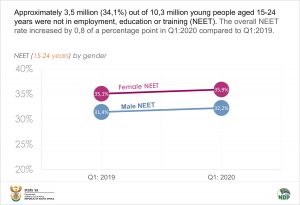Vulnerability of youth in the South African labour market
The results of the Quarterly Labour Force Survey (QLFS) for the first quarter of 2020 indicate that employment decreased by 38 000 to 16,4 million and the number of unemployed persons increased by 344 000 to 7,1 million. As a result, the official unemployment rate increased by 1 percentage point to (30,1%) compared to the fourth quarter of 2019. The rate has been persistently high over time with the youth (aged 15–34 years) being the most affected by joblessness.
In the first quarter of 2020, there were 20,4 million young people aged 15–34 years. These young people accounted for 63,3% of the total number of unemployed persons. The unemployment rate within this group was 43,2% in the 1st quarter of 2020. The youth aged 15–24 years are the most vulnerable in the South African labour market as the unemployment rate among this age group was 59,0% in the 1st quarter of 2020. Among graduates in this age group, the unemployment rate was 33,1% during this period compared to 24,6% in the 4th quarter of 2019 – an increase of 8,5 percentage points quarter-on-quarter. As high as it is, the graduate unemployment rate is still lower than the rate among those with other educational levels, meaning that education is still the key to these young people’s prospects improving in the South African labour market. Education in South Africa and around the world is recognised as a key instrument in human capital development. The more educated people are, the more likely are their chances for employment and jobs with good working conditions. Although the youth in the labour market are more vulnerable, those with a tertiary level of education have better chances of being employed.
The persistently high youth unemployment rate has long been one of the most pressing socio-economic problems in South Africa. Some of the young work-seekers are not well educated and do not possess sufficient skills and previous work experience demanded by employers in the labour market. The economy demands skilled and experienced work-seekers, which makes it difficult and lessens the chances for young people to find employment, which ultimately results in some losing hope of ever finding a job (thereby becoming discouraged work-seekers). In the first quarter of 2020, 1,9 million of the young people without work were discouraged from looking for work.
Some of these young people have disengaged with the labour market and they are also not building on their skills base through education and training – they are not in employment, education or training (NEET).
Of the 10,3 million persons aged 15-24 years in the first quarter of 2020, approximately 3,5 million or 34,1% were not in employment, education or training. Of the 20,4 million young people aged 15-34 years, about 8,5 million or 41,7% were not in employment, education or training . The NEET rate, seen in conjunction with high rates of unemployment, suggests that South African youth face extreme difficulties engaging with the labour market. Certain factors such as lack of experience and length of unemployment may increase the vulnerabilities of these young people in the labour market.
As indicated earlier, education and prior work experience play an important role in the labour market. Most often employers prefer to employ those with previous work experience and a higher level of education. Unfortunately, for the youth, lack of work experience is a stumbling block that results in them finding it hard to secure employment. Those with jobs are often employed on unspecified or limited contract duration, and consequently do not have access to employee benefits such as medical aid, pension fund, paid sick leave and permanent employment.
Youth unemployment is a major national challenge that needs urgent and coordinated responses to address it. Above all, a comprehensive strategy for youth employment, as part of a broader focus on expanding employment in South Africa, is necessary.
For more information on unemployment in South Africa, download the full report here.


